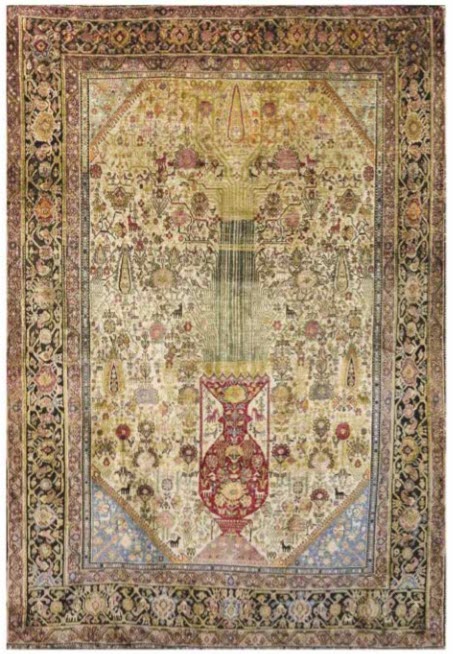Copyright 2020 - 2021 irantour.tours all right reserved
Designed by Behsazanhost
Evolution of carpet weaving in Kashan
Evolution of carpet weaving in Kashan
Kashan is located in the western part of the Lut Desert, at 258 kilometers from Tehran. This city had been on the caravans route between two cities, Qom and Isfahan, since ancient days. The people of this area in addition to agriculture do making handicrafts, knitting brocade, and weaving carpet. Based on excavations and objects which are obtained from Kashan and Rey, Experts believe that at least from the third millennium BC artisans from Kashan was quite familiar with weaving silk fabrics, and also they were taught the technique of painting underglaze on pottery. At the end of the year 621(AH.), this city was destroyed by changes from Mongolia but it was rebuilt in the following years, and artists and craftsmen began to work again. This development of weaving carpets was so that in the 10th Century (AH.) of the Shah Tahmasb era, Kashan became one of the important centers of carpet weaving and trained creative artists like Master Maghsoodi Kashani, who was the artist weaver of the famous carpets of Sheikh Safi’s mausoleum which are now kept in the Victoria and Albert Museum in British. The progress and development of the art of carpet weaving, dyeing, and designing in the 11th century (AH.) in this area was so that there also, like Isfahan, famous silk brocade carpets which are called "polonaises" or Polish carpets, were woven according to orders of noble families and Polish nobilities. After the fall of the Safavid and the domination of Afghans in the first half of the 12th century (AD), the weaving industry in Kashan, as well as other parts of Iran, went into decline. But in the late 13th century (AH), by the effort of a businessman, Mohtasham, weaving carpets was common in Kashan again and carpets of this area could equal exquisite carpets in the Safavid period. One of the special features of Kashan rugs is warm colors and a beautiful combination of colors. Using dark blue in medallion and margins that are balanced with ivory colors and other bright colors are common in Kashan.
Carpet weaving in Kashan is done by using asymmetric or Persian knots and using the Persian carpet loom. The rugs in this area often have double waft and the kind of warp is yarn or natural silk and the kind of pile is silk and cashmere wool which is the finest kind. Carpets from the early 13th century (AD) usually were woven with imported merino wool from Manchester, England, or Australia and they have special red. In the 13th century (AH.) By the mid-14th century (AH) carpets were woven in Kashan on a large scale. Most carpets were more than 10 square meters. And carpets with a size of smaller than 6 square meters, except for two cubits and the size of the cushion, rarely were made. But now in this area, carpets and rugs woven in various sizes are marketed.
Introducing a few examples of exquisite rugs of Kashan, in the Carpet Museum of Iran:
 |
1- Design name: prayer-nich - Tree - Inscription
Dimensions: 206 x 128 cm
Dating: Early 14th century
The design of this carpet is a prayer-nich that a tree is illustrated in and branches that surround the tree make an elongated oval design and Birds and leaves and flowering are throughout the text. Two narrow margins like a frame have covered the main text which contains the famous poem (the wind brings the smell of amber – brings almond and blossom on his head). Moreover, the palmette flower design and Eight-petal flowers are designed on the wide sidelines.
 |
2- Design name: prayer-nich - vase - Tree
Dimensions: 203 x 130 cm
Dating: early 14th century
This carpet is woven uneven and the method of weaving it is the Integration of kilim and rug which is called Suf. Since kilim has no knots so it is flat and the rug is tufted and uneven by its knots weaving these two methods together creates an uneven rug. The tree is a symbol of joy and immortality in Iranian art and its presence in the prayer-niche design which is based on religious beliefs is representative of eternal life and promises vitality and freshness.
 |
3-Design name: vase - the corner
Dimensions: 195 x 129 cm
Dating: Early 13th century
In rectangular frame large, red vase and on top of cypress tree with a split to the left and right, the medallion is formed. The texture of this Kashan Rug is different from other textures from that region and in terms of color and pattern is special. Carpet design includes humans and animals that are repeated symmetrically and the color of these animals is changed gradually from the bottom to up from black to red. Perhaps a way of this change is the sign of rising and animal evolution. The rest of the text is decorated with abstract flowers.
 |
4-Design name: Arabesque corner medallion
Dimensions: 200 x 126 cm
Dating: Early 14th century
The carpet has a medallion pattern in the middle of the carpet and a corner pattern around the carpet. corners are worked with Arabesque motifs and wide margin show flower patterns which have two leaves around. The pattern is called the “Arabesque section” because Arabesque lines are connected with repetitive sections.
- Details
- Category: IRAN Blog